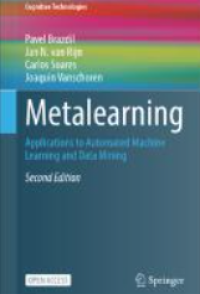
Text
E-book Metalearning : Applications to Automated Machine Learning and Data Mining
Penilaian
0,0
dari 5This book comprises three parts. In Part I (Chaps. 2–7) we sketch the basic concepts andarchitecture of metalearning systems, especially focusing on which types of “metaknowl-edge” can be collected by observing the performance of different models on prior tasksand how this can be used within metalearning approaches to learn new tasks more effi-ciently. Since this type of metalearning is closely related to automated machine learning(AutoML), we also cover this topic in some depth, but with a specific focus on how wecan improve AutoML through metalearning.Part II (Chaps. 8–15) covers different extensions of these basic ideas to more specifictasks. First, we discuss some methods that can be used in the design of configurationspaces that affect the search of metalearning and AutoML systems. Then, we show howmetalearning can be used to build better ensembles and to recommend algorithms forstreaming data. Next, we discuss how to transfer information from previously learnedmodels to new tasks, using transfer learning and few-shot learning in neural networks The final two chapters are dedicated to the problem of automating data science and thedesign of complex systems.Part III (Chaps. 16–18) provides practical advice on how to organize metadata inrepositories and how this can be leveraged in machine learning research. The last chapterincludes our closing remarks on and presents future challenges. We are surrounded by data. On a daily basis, we are confronted by many forms of it.Companies try to market their products with commercials in the form of billboardsand online advertisements. Large sensor networks and telescopes measure complex pro-cesses, happening around us on Earth or throughout the universe. Pharmaceutical in-stitutions record the interactions between types of molecules, in search of new medica-ments for new diseases.All this data is valuable, as it enables us to characterize different situations, learnto separate them into different groups, and incorporate this into a system that can helpus make decisions. We can thus identify fraudulent transactions from financial data,develop new medical drugs based on clinical data, or speculate about the evolution ofcelestial bodies in our universe. This process involveslearning.The scientific community has elaborated many techniques for analyzing and process-ing data. A traditional scientific task is modeling, where the aim is to describe the givencomplex phenomenon in a simplified way, in order to learn something from it. Many datamodeling techniques have been developed for that purpose based on various intuitionsand assumptions. This area of research is calledMachine Learning. As was shown, we cannot assume that there is one algorithm that works for all sorts ofdata, as each algorithm has its own area of expertise. Selecting the proper algorithm fora given task and dataset is key to obtaining an adequate model. This, in itself, can beseen as a learning task.This process of learning across tasks has generally been calledmetalearning. Overthe past decades, however, various machine learning researchers have used this termin many different ways, covering concepts such as meta-modeling, learning to learn,continuous learning, ensemble learning, and transfer learning. This large and growingbody of work has clearly demonstrated that metalearning can make machine learningdrastically more efficient, easier, and more trustworthy.
Ketersediaan
Informasi Detail
- Judul Seri
-
-
- No. Panggil
-
006.3 BRA m
- Penerbit
- Switzerland : Springer Nature., 2022
- Deskripsi Fisik
-
349 hlm
- Bahasa
-
English
- ISBN/ISSN
-
9783030670245
- Klasifikasi
-
006.3
- Tipe Isi
-
text
- Tipe Media
-
computer
- Tipe Pembawa
-
online resource
- Edisi
-
-
- Subjek
- Info Detail Spesifik
-
-
- Pernyataan Tanggungjawab
-
-
Versi lain/terkait
Tidak tersedia versi lain
Lampiran Berkas
Komentar
Anda harus masuk sebelum memberikan komentar
 Karya Umum
Karya Umum  Filsafat
Filsafat  Agama
Agama  Ilmu-ilmu Sosial
Ilmu-ilmu Sosial  Bahasa
Bahasa  Ilmu-ilmu Murni
Ilmu-ilmu Murni  Ilmu-ilmu Terapan
Ilmu-ilmu Terapan  Kesenian, Hiburan, dan Olahraga
Kesenian, Hiburan, dan Olahraga  Kesusastraan
Kesusastraan  Geografi dan Sejarah
Geografi dan Sejarah